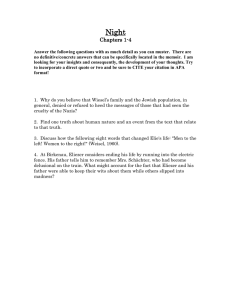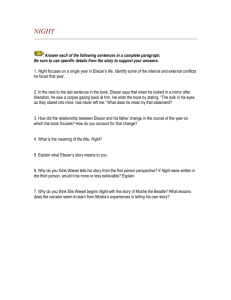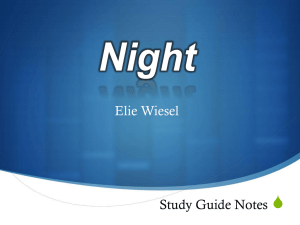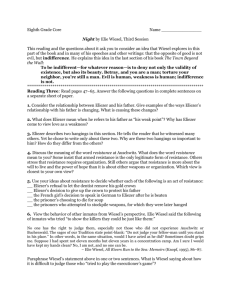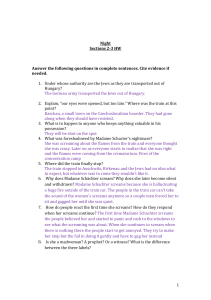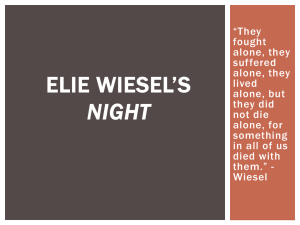Night Elie Wiesel
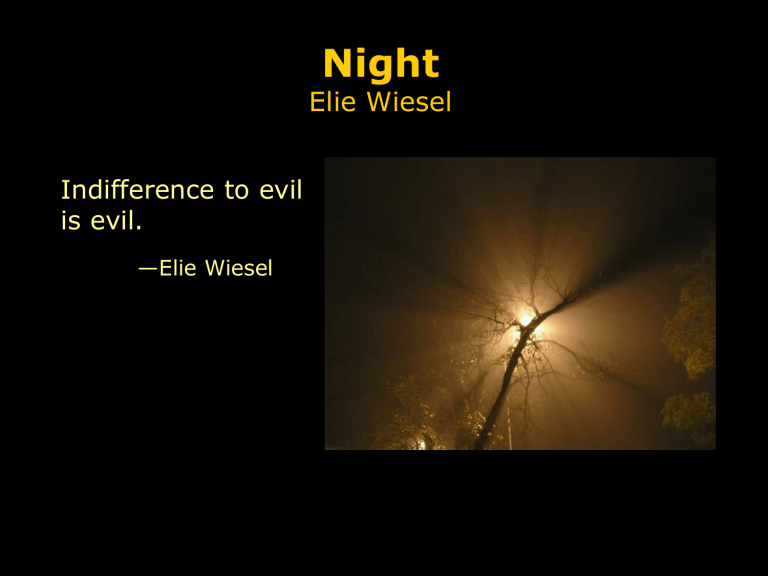
Indifference to evil is evil.
—Elie Wiesel
Night
Elie Wiesel
Night: Introduction
When you see something that’s wrong, do you just stand by?
Or do you act to try and stop it?
Night: Introduction
Elie Wiesel’s memoir Night describes a horrible time in the twentieth century, when too many people looked away from a terrible wrong.
Night: Introduction
In 1941, Eliezer was a twelve-year-old boy who lived with his father, mother, and three sisters in a small village near the border of
Romania and Hungary.
• 10th Grade Vocabulary, Unit 13
Name:______________________________________
Night: Introduction
Eliezer was a religious boy who welcomed nightfall as a time for prayer and who thought of becoming a rabbi.
Night: Introduction
But when Nazis took over Eliezer’s Jewish community, his family was first sent to live in a ghetto and then taken to Auschwitz, one of the most infamous concentration camps.
Night: Introduction
Eliezer and his father were separated from
Eliezer’s mother and sisters.
He would never see his mother or his youngest sister,
Tzipora, again.
Night: Introduction
Inside the camp, Eliezer will witness horrible acts of cruelty and suffer in terrible ways.
How will he survive?
Can his religious faith endure the atrocities he witnesses?
What message does he bring to the world from such horror?
Night: Background
In Night, Elie Wiesel shares his story of the
Holocaust, the name given to the persecution and murder of millions of Jews and others during World
War II.
Holocaust comes from a
Greek word that means
“a burnt offering.”
Night: Background
Germany began World War II when it invaded Poland in 1939.
German forces conquered most of Europe in the next two years.
Night: Background
Wiesel’s story begins in Romania (now Hungary) in
1941 and ends in 1944. When Germans took over this area, local Jews were persecuted.
They were forced to wear yellow stars and to live in ghettos, and were then sent to concentration camps.
Night: Background
Auschwitz, where Wiesel was sent, was the largest camp.
Jews from all over Europe arrived almost daily at
Auschwitz.
Night: Background
Nazis also targeted other groups:
• Romany (Gypsies)
• Russians
• non-Jewish Polish intellectual and religious leaders
• Communists
• Jehovah’s Witnesses
Night: Background
World War II ended in Europe in 1945 with the surrender of German forces to the Allied forces.
More than six million Jews had been killed in the
Holocaust.
Night: Background
Between 1945 and 1946, the Allies tried twentytwo major war criminals for their crimes against humanity.
In later years Israeli agents worked to capture and bring to justice Nazis who had escaped the war trials.
Night Terms/vocabulary to write in your notes:
Beadle
• a caretaker or “man of all work” in a synagogue.
Cabbala
• Jewish mysticism. Followers believe that every aspect of the Torah (first 5 books of
Hebrew Bible) has hidden meanings that link the spiritual world to everyday life.
Gestapo
• the German (non-uniformed) political police; popularly called the Secret State Police .
Ghetto
• A section of a city blocked off and reserved for a special group of people.
Kaddish
• A prayer Jews recite in memory of a loved one.
Maimonides
• A great Jewish scholar who lived in the twelfth century.
Messiah
• The savior and deliverer of the Jewish people.
• Jews believe the Messiah is yet to come; Christians believe that Jesus was the
Messiah.
SS
• Acronym for Schutzstaffel,
German for "protection squad".
• Formed in 1925 as Hitler's personal body guard; later became the elite units of the
Nazi party after 1929.
Synagogue
• a Jewish house of prayer.
Talmud
• A collection of teachings of early rabbis from the 5 th and 6 th centuries .
Zohar
• The Book of Splendor; a commentary on the Five Books of Moses and the major work of the cabbala.
Chapter 2:Figurative Language Terms
Review
• Simile – a comparison of two unlike things using the words “like” or “as.”
• Metaphor – a direct comparison of two unlike things.
• Personification - gives human characteristics to inanimate objects, animals, or ideas.
• Imagery – Vivid, descriptive language that appeals to one or more of the senses
(sight, hearing, touch, smell, and taste).
